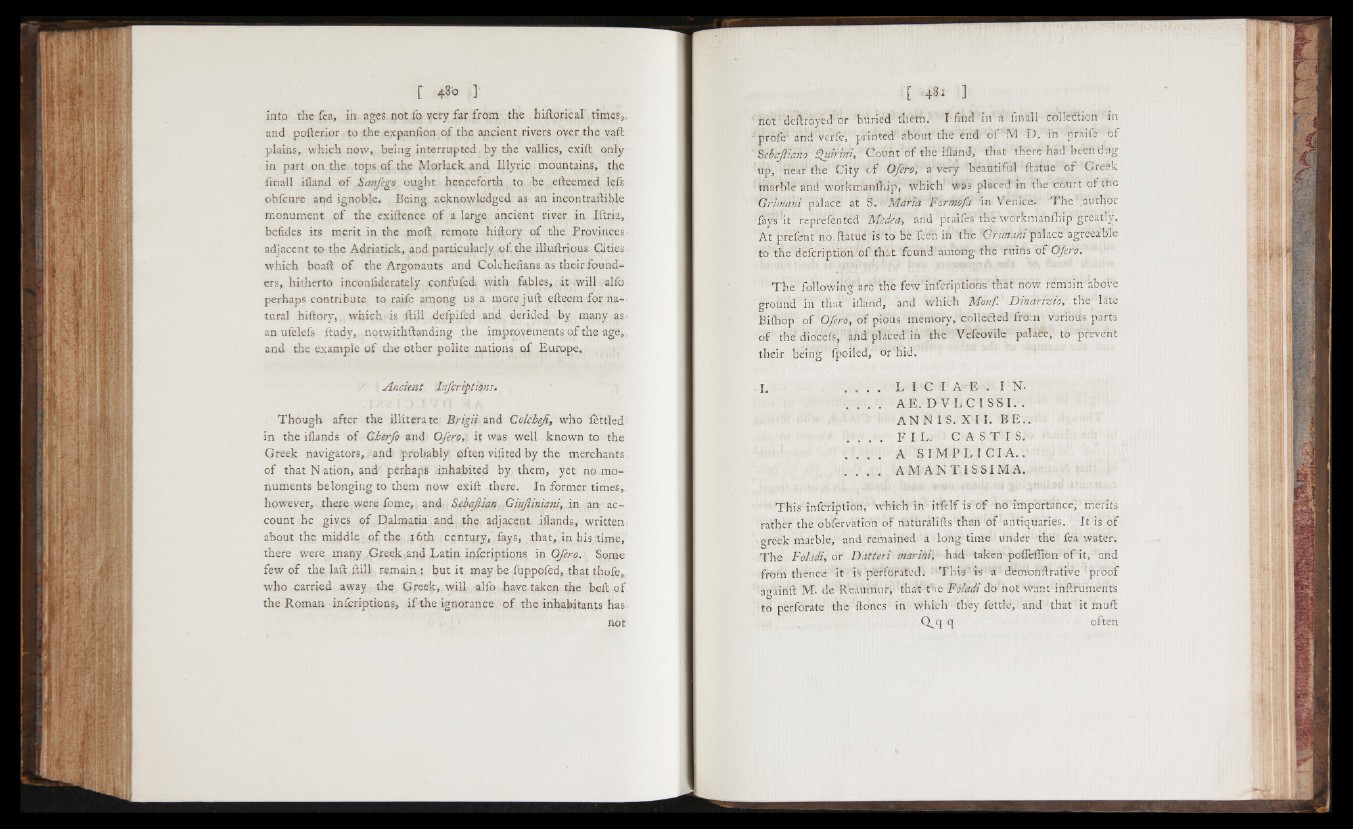
into the fea, in ages not fa very far from the hiilorical times,
and pofterior to the expanlion of the ancient rivers over the vail
plains, which now, being interrupted by the vallies, exift only
in part on the tops of the Morlack and Illyric mountains, the
fmall illand o f Sanfegp ought henceforth to be efteemed lefs
obfcure and ignoble. Being acknowledged as an incontraftible
monument o f the e'xiftence o f a large ancient river in Iftria,
befides its merit in the moil remote hiftory of the Provinces
adjacent to the Adriatick, and particularly'of. the illuilrious Cities
which boaft o f the Argonauts and Colchelians as their founders,
hitherto inconliderately confufecL with fables, it will alfo
perhaps contribute to raife among us a more juft eileem for natural
hiftory, which is ftill delpifed and derided by many as
an ufelefs ftudy, notwithftanding the improvements o f the age,,
and the example o f the other polite nations of Europe.
: Ancient Infcriptions,
Though after the illiterate Brigii and Colchefi, who fettled
in the illands o f Gberfo and Ofero, it was well known to the
Greek navigators, and probably often vifited by the merchants
of that N ation, and perhaps inhabited by them, yet no monuments
belonging to them now exift there. In former times,
however, there were fome, and Sebajlian, Giujiiniani, in an account
he gives pf Dalmatia and the adjacent illands, written'
about the middle o f the 16th century, fays, that, in his time,
there were many Greek and Latin infcriptions in Ofero. Some
few o f the laft ftill remain : but it may be fuppofed, that thofe,
who carried away the Greek, will alfo have taken the bell of
the Roman infcriptions, i f the ignorance o f the inhabitants has
not
hot " deliroyed* or buried them. I find in a finali còl ledlion in
■pròle* and verfe, printed about the end o f IVI D. in praife ò f
Sebajltano Quhini, Count of the illand, that there had been dug
up, near' the City c f Ofero, a very beautiful ftatue o f Greek
marble and workman fh'ip, whith was placed in the court o f the
Griniani palace at S. Mafia Formo/a in Venite. T h e ’ .author
fays 'it reprefen ted Medea, and praifes' the workmanfliip greatly.
At prefent no.ftatue is to be feeti in the Gfimahipalace agreeable
to the defcription o f that, found’amohg the ruins of Ofero.
The following are the few infcriptiohs that now remain above
ground in that illand, and which Monf. DinarissiO, the late
Biftiop of Ofero, o f pious memory, colleded from various parts
o f the dioeefs, and placed in the Vefeovile palarie, to prevent
their being fpoiled, or hid.
I. , , r . L I C I A E . I N.
. . . . AE. D V L C I S S I . .
A N N IS. X I I . BE. .
F I L . C A S T I S.
. . . . A S I M P L I C I A . .
. . . . A M A N T I S S I M A .
This infcription, which in itfelf is o f no importance, merits
rather the observation of naturalifts than o f antiquaries. It is o f
greek marble, and remained a long time under the fea water.
The Foladi, or Datteri marini, had taken poffeffion o f i t , 1 and
from thence it is perforated. This "is a demonftrative 'proof
auainft M. de Reaumur, that the Foladi do O . , . I not • want inftrum, ents
to perforate the ftones in which they lcttle, and that it mull
Q j ] q often